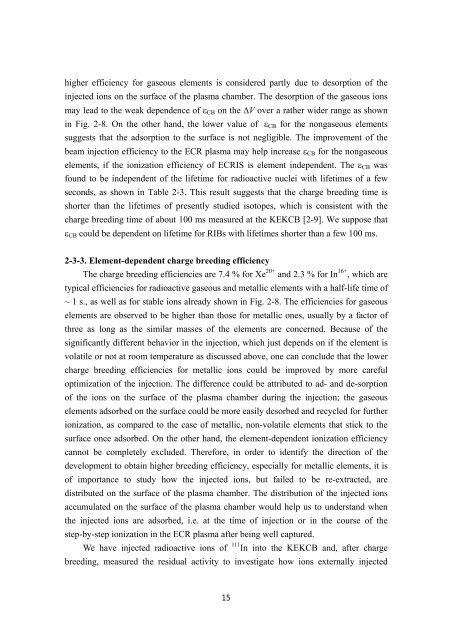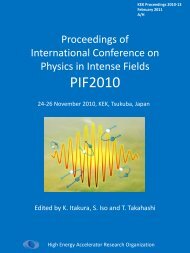TRIAC Progress Report - KEK
TRIAC Progress Report - KEK
TRIAC Progress Report - KEK
Create successful ePaper yourself
Turn your PDF publications into a flip-book with our unique Google optimized e-Paper software.
higher efficiency for gaseous elements is considered partly due to desorption of the<br />
injected ions on the surface of the plasma chamber. The desorption of the gaseous ions<br />
may lead to the weak dependence of εCB on the ∆V over a rather wider range as shown<br />
in Fig. 2-8. On the other hand, the lower value of εCB for the nongaseous elements<br />
suggests that the adsorption to the surface is not negligible. The improvement of the<br />
beam injection efficiency to the ECR plasma may help increase εCB for the nongaseous<br />
elements, if the ionization efficiency of ECRIS is element independent. The εCB was<br />
found to be independent of the lifetime for radioactive nuclei with lifetimes of a few<br />
seconds, as shown in Table 2-3. This result suggests that the charge breeding time is<br />
shorter than the lifetimes of presently studied isotopes, which is consistent with the<br />
charge breeding time of about 100 ms measured at the <strong>KEK</strong>CB [2-9]. We suppose that<br />
εCB could be dependent on lifetime for RIBs with lifetimes shorter than a few 100 ms.<br />
2-3-3. Element-dependent charge breeding efficiency<br />
The charge breeding efficiencies are 7.4 % for Xe 20+ and 2.3 % for In 16+ , which are<br />
typical efficiencies for radioactive gaseous and metallic elements with a half-life time of<br />
~ 1 s., as well as for stable ions already shown in Fig. 2-8. The efficiencies for gaseous<br />
elements are observed to be higher than those for metallic ones, usually by a factor of<br />
three as long as the similar masses of the elements are concerned. Because of the<br />
significantly different behavior in the injection, which just depends on if the element is<br />
volatile or not at room temperature as discussed above, one can conclude that the lower<br />
charge breeding efficiencies for metallic ions could be improved by more careful<br />
optimization of the injection. The difference could be attributed to ad- and de-sorption<br />
of the ions on the surface of the plasma chamber during the injection; the gaseous<br />
elements adsorbed on the surface could be more easily desorbed and recycled for further<br />
ionization, as compared to the case of metallic, non-volatile elements that stick to the<br />
surface once adsorbed. On the other hand, the element-dependent ionization efficiency<br />
cannot be completely excluded. Therefore, in order to identify the direction of the<br />
development to obtain higher breeding efficiency, especially for metallic elements, it is<br />
of importance to study how the injected ions, but failed to be re-extracted, are<br />
distributed on the surface of the plasma chamber. The distribution of the injected ions<br />
accumulated on the surface of the plasma chamber would help us to understand when<br />
the injected ions are adsorbed, i.e. at the time of injection or in the course of the<br />
step-by-step ionization in the ECR plasma after being well captured.<br />
We have injected radioactive ions of 111 In into the <strong>KEK</strong>CB and, after charge<br />
breeding, measured the residual activity to investigate how ions externally injected<br />
15













